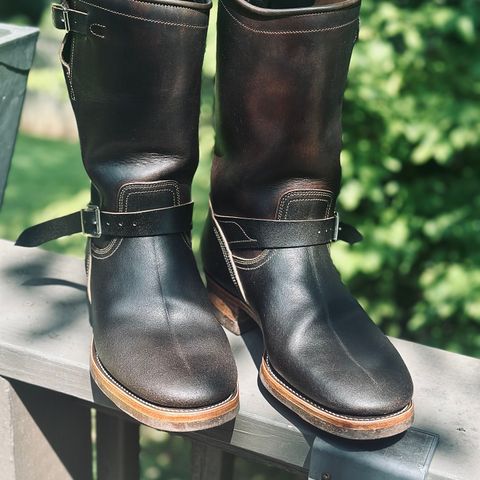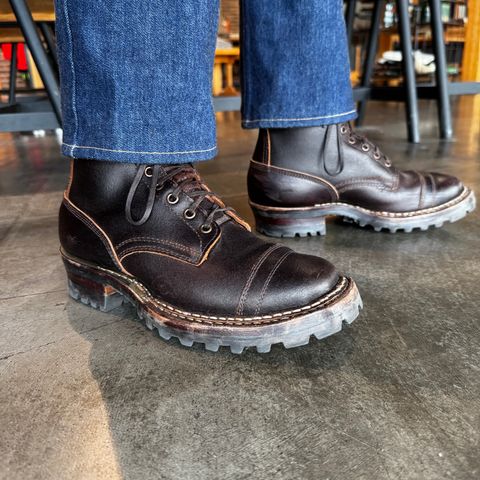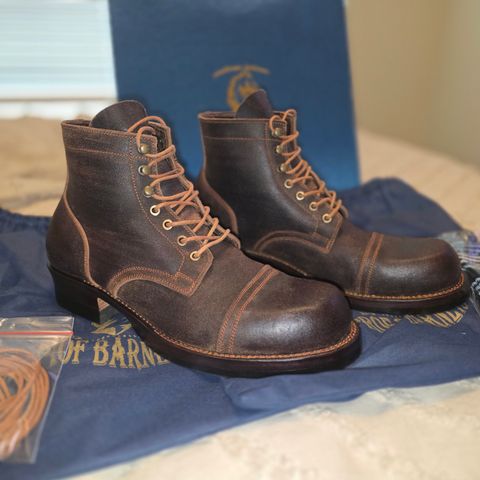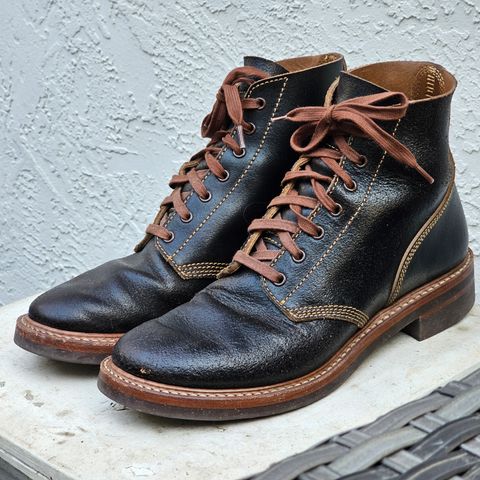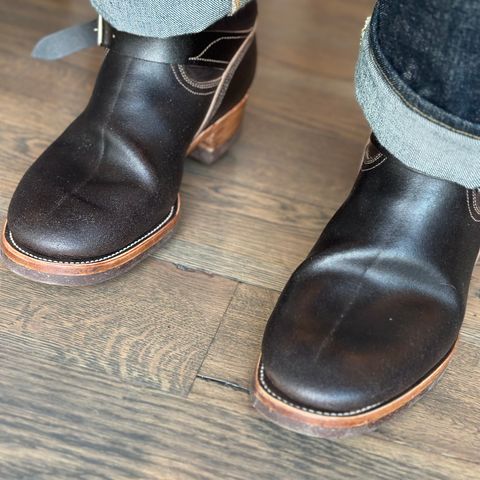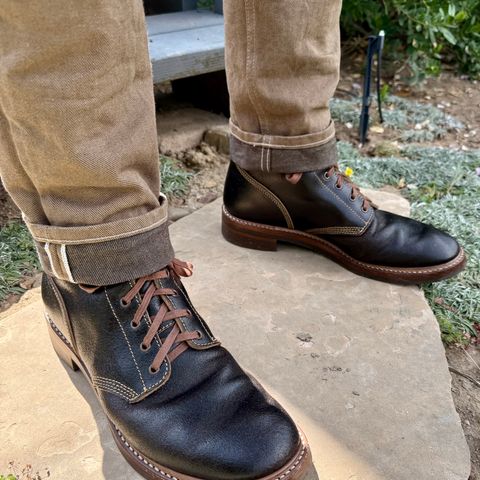About
Horween Dark Brown Waxed Flesh is a specialty leather color variation of Horween's acclaimed waxed flesh leather, characterized by its rich, dark brown pigmentation and unique flesh-side finishing. This leather begins as a deep, dark brown color and develops a distinctive patina over time, lightening to medium brown tones as the wax finish wears away to reveal the sand-colored nap beneath. The leather combines the durability and pull-up characteristics of Horween's Chromexcel base with enhanced water resistance and a unique aging process that makes each piece develop its own character through use.
About
Horween Dark Brown Waxed Flesh is a specialty leather color variation of Horween's acclaimed waxed flesh leather, characterized by its rich, dark brown pigmentation and unique flesh-side finishing. This leather begins as a deep, dark brown color and develops a distinctive patina over time, lightening to medium brown tones as the wax finish wears away to reveal the sand-colored nap beneath. The leather combines the durability and pull-up characteristics of Horween's Chromexcel base with enhanced water resistance and a unique aging process that makes each piece develop its own character through use.
Manufacturing Process
Dark Brown Waxed Flesh is created using Horween's traditional Chromexcel leather as its foundation, which undergoes at least 89 separate processes over 28 working days utilizing all five floors of Horween's Chicago facility. The manufacturing process begins with combination tanning, starting with a chrome base achieved using chrome salts, followed by a full vegetable re-tannage. The leather then undergoes hot stuffing, where hides are impregnated with oils, waxes, and greases that are solid at room temperature using steamed mills.
The distinctive characteristic of waxed flesh lies in its finishing process. Unlike traditional Chromexcel, which is finished on the grain side, Dark Brown Waxed Flesh is finished on the flesh (suede) side. Horween applies its proprietary hand-dyeing procedure to the flesh side, followed by hand glazing to provide a tight flesh surface and final luster. The dark brown pigmentation is applied during this process, coating the flesh side while the leather is still flat to achieve perfect slick application to the fibers.
Historical Background
Waxed flesh leather traces its origins to World War II when Horween served as the official supplier of leather for the U.S. Marine Corps. The company used their iconic Chromexcel leather, invented in 1913, with the fibrous flesh side facing outward—a configuration the U.S. military referred to as "roughout." Marines and soldiers would coat the exterior of their boots with dubbin, a mixture of natural waxes and oils, to enhance the leather's already naturally water-resistant properties.
This wartime application established the foundation for what would become Horween's modern waxed flesh process. The leather is also known as French Waxed Calf, representing Horween's interpretation of the traditional French leather-making technique.
Characteristics and Properties
Dark Brown Waxed Flesh exhibits exceptional water resistance due to the professional wax application during the tanning process. The wax saturates the leather fibers and creates a slicked-down surface that resists rain, scuffs, and environmental elements. This water resistance helps prevent the drying effects that can damage vegetable-tanned leathers when exposed to moisture.
The leather requires minimal maintenance and conditioning due to its inherent oil and wax content. The hot stuffing process ensures the leather remains supple and durable without frequent treatment, making it ideal for applications requiring low-maintenance durability.
Patina Development
One of the most distinctive features of Dark Brown Waxed Flesh is its patina development over time. The leather is designed to age by revealing the sand-colored nap of the flesh side through prolonged use. Areas subjected to frequent contact, such as boot heels rubbing against surfaces or toes kicking objects, will show the most dramatic changes.
The dark brown coloration gradually lightens to medium brown tones as the wax coating wears away, creating a unique two-tone appearance. This patina development is not uniform across the entire surface, resulting in a characteristic weathered appearance that reflects the wearer's specific usage patterns. The underlying sand-colored nap becomes increasingly visible, creating texture and visual depth that distinguishes each piece.
Applications and Uses
Dark Brown Waxed Flesh is particularly well-suited for unlined footwear applications due to its water resistance and durability. The leather's ability to withstand harsh conditions while developing an attractive patina makes it popular among boot manufacturers producing work boots, hiking boots, and heritage-style footwear.
The leather's properties also make it suitable for other applications requiring durability and water resistance, including bags, belts, and outdoor gear. Its low maintenance requirements and ability to improve with age appeal to users who value both functionality and character development in their leather goods.
Care and Maintenance
Dark Brown Waxed Flesh requires minimal care due to its inherent wax and oil content from the manufacturing process. The leather's water-resistant properties help protect against environmental damage, and the wax finish provides ongoing protection as it gradually wears away.
When conditioning is eventually needed, light applications of appropriate leather conditioners can help maintain the leather's suppleness without interfering with its natural aging process. Heavy conditioning should be avoided as it may alter the intended patina development and water-resistant characteristics that define this leather's unique properties.
References
"Waxed Flesh Leather: Properties and Care". Horween Leather Co. July 15, 2019.
"Understanding Waxed Flesh Leather". Viberg Boot. Retrieved September 7, 2025.
"Dark Brown Leather Finishes". The Shoe Mart. Retrieved September 7, 2025.
"Flesh Side Out Leather Construction". White's Boots. Retrieved September 7, 2025.
"Waxed Flesh Applications in Premium Footwear". Baker Shoe. Retrieved September 7, 2025.
